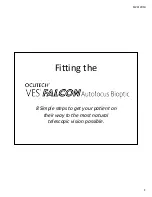
Refractor Telescopes
Refractor telescopes use a series of concave and convex lenses to bend light coming in
the objective lens to a focus at the eyepiece. The light path travels straight through the
optical tube without any mirrors needed to redirect the light toward the eyepiece.
Reflector Telescopes
Reflector telescopes use a series of mirrors to bring light to focus at the eyepiece, which
extrudes from the side of the telescope tube. Light enters the open objective end of the
tube and is then bounced off of a parabolic mirror toward the secondary mirror. The
secondary mirror redirects the light out of the side of the tube toward the eyepiece. The
secondary mirror blocks a small portion of the light coming in the front of the optical
tube as it is in the light path.
Telescope Image Orientation
Catadioptric Telescopes
Catadioptric telescopes combine lenses and mirrors to bring light to focus at the eye-
piece, which extrudes either out the side of the optical tube, or through a hole in the
center of the primary mirror. Catadioptric telescopes provide a wider field of view than
reflector telescopes and correct focus to be the same across the entire field of view. Cata-
dioptric telescopes also lose a small portion of the light they gather due to obstruction
by the secondary mirror.
Image Orientation
Images viewed through a telescope will appear to be flipped both horizontally and
vertically (rotated 180 ). When viewing celestial objects, image orientation is of little
concern, but if you would like to use your telescope for terrestrial use, you will need
to use an erecting prism to correct the image orientation. An image diagonal will also
partially correct the image by flipping the image vertcally, but the image will still ap-
pear backwards. To correct the image in a reflector telescope, you will need a par-focal
erecting eyepiece which also increases the magnificaiton of your eyepiece by a factor
of 1.5x.
Telescope Image with Diagonal
Telescope Image with Erecting Prism
Summary of Contents for Kepler
Page 1: ...KEPLER 152...


























